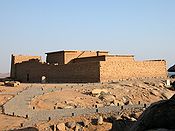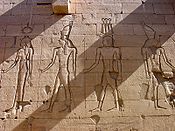
Temple of Kalabsha
Encyclopedia


Ancient Egypt
Ancient Egypt was an ancient civilization of Northeastern Africa, concentrated along the lower reaches of the Nile River in what is now the modern country of Egypt. Egyptian civilization coalesced around 3150 BC with the political unification of Upper and Lower Egypt under the first pharaoh...
ian temple
Egyptian temple
Egyptian temples were built for the official worship of the gods and commemoration of pharaohs in Ancient Egypt and in regions under Egyptian control. These temples were seen as houses for the gods or kings to whom they were dedicated...
that was originally located at Bab al-Kalabsha (Gate of Kalabsha), approximately 50 kilometers south of Aswan
Aswan
Aswan , formerly spelled Assuan, is a city in the south of Egypt, the capital of the Aswan Governorate.It stands on the east bank of the Nile at the first cataract and is a busy market and tourist centre...
. The temple was situated on the west bank of the Nile River, in Nubia
Nubia
Nubia is a region along the Nile river, which is located in northern Sudan and southern Egypt.There were a number of small Nubian kingdoms throughout the Middle Ages, the last of which collapsed in 1504, when Nubia became divided between Egypt and the Sennar sultanate resulting in the Arabization...
, and was originally built around 30 BC during the early Roman
Ancient Rome
Ancient Rome was a thriving civilization that grew on the Italian Peninsula as early as the 8th century BC. Located along the Mediterranean Sea and centered on the city of Rome, it expanded to one of the largest empires in the ancient world....
era. While the temple was constructed in Augustus's reign, it was never finished. The temple was a tribute to Mandulis
Mandulis
The Temple of Kalabsha in Nubia was dedicated to Mandulis which was a Nubian form of Horus. A cult dedicated to Mandulis can also be found in Egypt, at Philae....
(Merul), a Lower Nubian sun god. It was constructed over an earlier sanctuary of Amenhotep II. The temple is 76 meters long and 22 meters wide in dimension. While the structure dates to the Roman period, it features many fine reliefs such as "a fine carving of Horus emerging from reeds on the inner curtain wall" of the temple. From Kalabsha's "sanctuary chambers, a staircase leads up to the roof of the temple" where one can see a splendid view of the temple itself and the sacred lake. Several historical records were inscribed on the temple walls of Kalabsha such as "a long inscription carved by the Roman Governor Aurelius Besarion in AD 250, forbidding pigs in the temple" as well as an inscription of "the Nubian king Silko, carved during the 5th century and recording his victory over the Blemmyes
Blemmyes
The Blemmyes were a nomadic Nubian tribe described in Roman histories of the later empire. From the late third century on, along with another tribe, the Nobadae, they repeatedly fought the Romans...
and a picture of him dressed as a Roman soldier on horseback." Silko was the Christian king of the Nubian kingdom of Nobatia
Nobatia
Nobatia or Nobadia was an ancient African Christian kingdom in Lower Nubia and subsequently a region of the larger Nubian Kingdom of Makuria...
.
Later use and movement of the temples
When ChristianityChristianity
Christianity is a monotheistic religion based on the life and teachings of Jesus as presented in canonical gospels and other New Testament writings...
was introduced to Egypt
Egypt
Egypt , officially the Arab Republic of Egypt, Arabic: , is a country mainly in North Africa, with the Sinai Peninsula forming a land bridge in Southwest Asia. Egypt is thus a transcontinental country, and a major power in Africa, the Mediterranean Basin, the Middle East and the Muslim world...
, the temple was used as a church.
With help from Germany
Germany
Germany , officially the Federal Republic of Germany , is a federal parliamentary republic in Europe. The country consists of 16 states while the capital and largest city is Berlin. Germany covers an area of 357,021 km2 and has a largely temperate seasonal climate...
, the temple of Kalabsha was relocated after the Aswan High Dam was built, to protect it from rising waters on Lake Nasser
Lake Nasser
Lake Nasser is a vast reservoir in southern Egypt, and northern Sudan, and is one of the largest man-made lakes in the world. Strictly, "Lake Nasser" refers only to the much larger portion of the lake that is in Egyptian territory , with the Sudanese preferring to call their smaller body of water...
. The temple was moved to a site
New Kalabsha
New Kalabsha is a promontory located near Aswan in Egypt. It houses several important temples, structures, and other remains that have been relocated here from the site of Old Kalabsha to avoid the rising waters of Lake Nasser caused by the construction of the Aswan High Dam...
, located just south of the Aswan High Dam. The process of moving the temple took more than two years. The temple of Kalabsha was the largest free-standing temple of Egyptian Nubia (after Abu Simbel) to be moved and erected at a new site. Its design was standard for the Ptolemaic period with pylons, courtyard, hypostyle hall and three room sanctuaries. Although the building was never completed, it "is regarded as one of the best examples of Egyptian architecture in Nubia."

